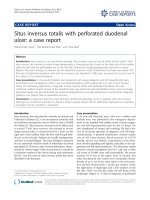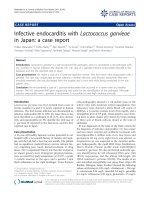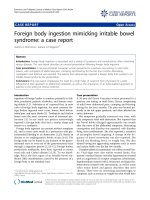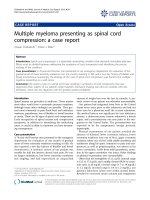Báo cáo y học: " Benzocaine and lidocaine induced methemoglobinemia after bronchoscopy: a case report" pptx
Bạn đang xem bản rút gọn của tài liệu. Xem và tải ngay bản đầy đủ của tài liệu tại đây (218.17 KB, 4 trang )
BioMed Central
Page 1 of 4
(page number not for citation purposes)
Journal of Medical Case Reports
Open Access
Case report
Benzocaine and lidocaine induced methemoglobinemia after
bronchoscopy: a case report
Sophie Kwok*, Jacqueline L Fischer and John D Rogers
Address: Department of Internal Medicine, University of Illinois College of Medicine at Peoria, Peoria, Illinois, USA
Email: Sophie Kwok* - ; Jacqueline L Fischer - ; John D Rogers -
* Corresponding author
Abstract
Introduction: Methemoglobinemia is a rare cause of hypoxemia, characterized by abnormal levels
of oxidized hemoglobin that cannot bind to and transport oxygen.
Case presentation: A 62-year-old male underwent bronchoscopy where lidocaine oral solution
and Hurricaine spray (20% benzocaine) were used. He developed central cyanosis and his oxygen
saturation was 85% via pulse oximetry. An arterial blood gas revealed pH 7.45, P
CO2
42, P
O2
282,
oxygen saturation 85%. Co-oximetry performed revealed a methemoglobin level of 17.5% (normal
0.6–2.5%). The patient was continued on 15 L/minute nonrebreathing face mask and subsequent
oxygen saturation improved to 92% within two hours. With hemodynamic stability and improved
SpO
2
, treatment with methylene blue was withheld.
Conclusion: Methemoglobinemia is a potentially lethal condition after exposure to routinely used
drugs. Physicians should be aware of this complication for early diagnosis and treatment.
Introduction
Methemoglobinemia is an uncommon [1,2] but poten-
tially fatal hemoglobinopathy. It leads to rapid oxygen
desaturation, and therefore requires prompt recognition
and treatment. This condition is often reported in the
perioperative period when topical anesthetics are used
during bronchoscopy, laryngoscopy, or upper gastrointes-
tinal endoscopy. We present a case of a patient who devel-
oped methemoglobinemia after the use of both topical
lidocaine and topical benzocaine for bronchoscopy.
Case presentation
A 62-year-old Caucasian male with a past medical history
of hypertension, hyperlipidemia, and cervical spine oste-
oarthritis was hospitalized for the problems of worsening
chronic neck pain, new bilateral upper arm pain, and a
persistent leukocytosis with an absolute monocytosis. His
weight was 106.59 kg and height was 185.42 cm. His
baseline hemoglobin and hematocrit were 11.1 grams/dL
and 33.6% respectively. The described pain was intermit-
tent, severe, and at times lancinating in nature. The
patient underwent extensive diagnostic testing for the
above mentioned problems and was ultimately diagnosed
with complex regional pain syndrome. The patient was
begun on steroid therapy and an improvement in his
symptoms followed. The etiology of the leukocytosis and
monocytosis remained unclear at the time of discharge.
Other medications he received during hospitalization
include: cephalexin, amitryptyline, amlodipine, enoxa-
parin, gabapentin, pantoprazole, oxycodone, and pravas-
tatin.
During the hospitalization, a computed tomography (CT)
scan of the chest, done as part of the investigation for the
Published: 23 January 2008
Journal of Medical Case Reports 2008, 2:16 doi:10.1186/1752-1947-2-16
Received: 20 March 2007
Accepted: 23 January 2008
This article is available from: />© 2008 Kwok et al; licensee BioMed Central Ltd.
This is an Open Access article distributed under the terms of the Creative Commons Attribution License ( />),
which permits unrestricted use, distribution, and reproduction in any medium, provided the original work is properly cited.
Journal of Medical Case Reports 2008, 2:16 />Page 2 of 4
(page number not for citation purposes)
monocytosis, revealed bilateral ground glass pulmonary
opacities. Further evaluation with bronchoscopy was per-
formed. Topical pharyngeal anesthesia was achieved with
100 mL lidocaine hydrochloride solution orally, 4 mL of
lidocaine aerosol, and 10 mL lidocaine jelly 2% topically.
The patient was sedated with a total of 8 mg of midazolam
and 50 mcg of fentanyl. His oropharynx was sprayed two
times (one second each spray) with non-metered dose
Hurricaine topical anesthetic aerosol spray (20% benzo-
caine) in preparation for bronchoscopy. The endoscope
was inserted into the trachea and bronchi without diffi-
culty.
During the procedure, the patient's oxygen saturation was
94% via pulse oximetry. Thirty minutes after the proce-
dure, the patient developed central cyanosis, and his oxy-
gen saturation decreased to 85% via pulse oximetry. His
blood pressure was 152/77 mmHg and heart rate was 89
beats for minute. His cardiovascular and chest examina-
tions were within normal limits. The patient did complain
of being uncomfortable.
Oxygen was administered by nonrebreathing face mask
initially at 10 L/minute, then at 15 L/minute when the
cyanosis did not resolve. A chest radiograph was unre-
markable. A chest CT was performed and showed no evi-
dence of pulmonary embolism. An arterial blood gas
revealed pH 7.45, P
CO2
42, P
O2
282, oxygen saturation
85%. The color of arterial blood was not noted. Co-oxi-
metry performed revealed a methemoglobin level of
17.5% (normal 0.6–2.5%). A diagnosis of methemoglob-
inemia was made. The patient was continued on 15 L/
minute nonrebreathing face mask and subsequent oxygen
saturation improved to 92% within two hours. With
hemodynamic stability and improved SpO
2
, treatment
with methylene blue was withheld.
The patient's oxygen requirements lessened to 3 L/minute
by nasal cannulae within 12 hours and his cyanosis
resolved. Repeat arterial blood gas the next morning
revealed a methemoglobin level of 1.1% by co-oximetry
and the patient was doing well on room air. He had no
adverse sequelae and the bronchoscopy revealed no
abnormal findings. He remained in the hospital for sev-
eral more days for treatment of his other medical condi-
tions.
Discussion
Methemoglobin develops when iron in hemoglobin is
oxidized from the ferrous state (Fe
2+
) to the ferric state
(Fe
3+
). When the iron of hemoglobin is oxidized to Fe
3+
,
it is unable to carry oxygen. In healthy adults, methemo-
globin accounts for less than 2% of total hemoglobin.
This level is maintained primarily by the transfer of elec-
trons from nicotinamide adenine dinucleotide (NADH)
to NADH-cytochrome b5 reductase and then to cyto-
chrome b5 [3].
Methemoglobinemia may be an inherited or acquired dis-
order. Inherited methemoglobinemia is rare and patients
lack the enzyme NADH methemoglobin reductase (auto-
somal recessive deficiencies in cytochrome b5 or cyto-
chrome b5 reductase). This form is most common in
Alaskan Native Americans and individuals of Inuit
descent [4,5]. Another less common form of congenital
methemoglobinemia occurs in individuals who have an
aberrant form of hemoblogin (HbM), where the reduced
ferrous ion is destabilized and is more easily oxidized to a
ferric ion. In addition, the enzyme methemoglobin
reductase cannot interact with and efficiently reduce the
methemoglobin in individuals who display this form of
hemoglobin [6].
Acquired methemoglobinemia is more common than
hereditary causes and occurs when an exogenous sub-
stance oxidizes hemoglobin producing methemoglobin at
rates 100 to 1000 times greater than it can be metabo-
lized. A wide variety of substances (Table 1) are known to
induce methemoglobinemia, including amyl nitrite,
nitroglycerin, dapsone, phenacetin, phenytoin, pri-
maquine, sulfonamides, and local anesthetics such as
lidocaine and benzocaine [7].
Factors that predispose to pharmacologic-induced methe-
moglobinemia include an excessive dose, a break in the
normal mucosal barrier (which may increase the systemic
absorption), and the concomitant use of other drugs
known to cause methemoglobinemia.
Our patient received a combination of topical lidocaine
and benzocaine, perhaps rendering him more susceptible
to methemoglobinemia. A review of literature on lido-
caine as a cause of methemoglobinemia is rarely reported.
It almost always occurs in the setting of other agents and
comorbidities [8]. Benzocaine is a more common cause of
methemoglobinemia and reported more frequently in the
literature. Based on one institution, the incidence of ben-
zocaine-induced methemoglobinemia is one in 7000
bronchoscopies [1]; however, the exact incidence of meth-
emoglobinemia associated with benzocaine is unknown.
Because benzocaine is more lipophilic, it may continue to
enter the blood stream from adipose tissue stores after
methylene blue blood concentrations are no longer ther-
apeutic [9]. Benzocaine is a more powerful oxidizing
agent than lidocaine in animal studies, and a dose-
response relationship has been demonstrated between
benzocaine and methemoglobin [10,11]. Another risk
factor for developing pharmacologic-induced methemo-
globinemia is concomitant illnesses, such as cardiac and
respiratory diseases [12]. Concentration of methemo-
Journal of Medical Case Reports 2008, 2:16 />Page 3 of 4
(page number not for citation purposes)
globin is reported as the percentage of total hemoglobin.
Although hemoglobin level does not directly affect the
production of methemoglobin, it does affect the amount
of functional anemia. Our patient did have baseline ane-
mia, which put him at a higher risk of developing more
symptoms of methemoglobinemia. Furthermore, a non-
metered dose Hurricaine topical anesthetic aerosol spray
(20% benzocaine) was used in our patient, rather than a
metered dose spray. The manufacturer recommends a
dose of benzocaine 20% half-second spray that delivers
30 mg, so our patient probably received a relative over-
dose of benzocaine [13]. Infants are more susceptible
than adults because hemoglobin F is more susceptible to
oxidation [14]. In our case, the likelihood of an adverse
drug reaction using the Naranjo probability scale was cal-
culated to be probable (score of 6) [15]. Our conclusion
was based on previous reports on this reaction; the
adverse event appearing after the suspected drugs were
administered; the adverse reaction improving when the
drugs were discontinued; the drug being detected in the
blood in a toxic concentration, and confirmation with
objective evidence.
Clinical symptoms and signs depend on the level of meth-
emoglobin. Levels greater than 15% are associated with
cyanosis. Levels of 20–45% cause headache, anxiety, leth-
argy, tachycardia, lightheadedness, weakness, and dizzi-
ness. Dyspnea, acidosis, cardiac dysrhythmias, heart
failure, seizures, and coma occur at levels above 45%.
Methemoglobin levels above 60% are associated with a
high mortality rate, and levels greater than 70% are fatal
[3].
The diagnosis of methemoglobinemia is made by analysis
of an arterial blood sample, using co-oximetry, which
demonstrates a discrepancy between a low arterial oxyhe-
moglobin saturation (SaO
2
) and a relatively high arterial
oxygen partial pressure (PaO
2
). A standard arterial blood
gas analyzer measures the partial pressure of oxygen and
calculates the oxygen saturation from this value. This is
inaccurate because the methemoglobin level is assumed
to be zero. However, a co-oximetry is a simplified specto-
photometer that measure light absorbency at four differ-
ent wavelengths and these wavelengths correspond to
specific absorbency characteristics of deoxyhemoglobin,
oxyhemoglobin, carboxyhemoglobin, and hemoglobin.
In the presence of methemoglobinemia, oxygenation
obtained by pulse oximetry is inaccurate because it does
not reflect the degree of desaturation and can under or
over estimate oxygenation depending on the severity of
methemoglobinemia. The diagnosis should be suspected
if cyanosis develops suddenly after the administration of
oxidizing agents, or if chocolate brown arterial blood does
not turn red on exposure to air [2].
In the absence of serious underlying illness, methemo-
globin levels less than 30% usually resolve spontaneously
over 15–20 hours when the offending agent is removed
and oxygen is administered. Our patient did not receive
methylene blue because he improved quickly with oxygen
administration and his methemoglobin level was less
than 30%. Methylene blue improves the efficiency of
NADH methemoglobin reductase, and is an effective
treatment for this condition. It is administered at a dose of
1–2 mg/kg IV slowly over 3–10 minutes. Improvement
should occur within one hour, but if cyanosis persists, a
second dose of methylene blue should be given [12].
Higher doses of methylene blue (> 7 mg/kg) may cause
hemolysis and persistent cyanosis because the agent will
oxidize hemoglobin to methemoglobin, instead of acting
as a reducing agent at lower doses [13]. Methylene blue
itself has side effects, which include nausea, vomiting,
diarrhea, dyspnea, burning sensation in the mouth and
abdomen, restlessness, and perspiration. The agent is an
ineffective treatment for G6PD-deficient patients because
G6PD generates NADPH, which acts as the reducing agent
to convert methemoglobin to hemoglobin. Therefore,
methylene blue would lead to the formation of more
Table 1: Common medications and chemicals known to cause methemoglobinemia [7].
Acetaminophen Hydroxylamine Nitrosobenzene
Acetanilide Local anesthetics Phenacetin
Aminophenols Benzocaine Phenols
Ammonium nitrate Cocaine Phenytoin
Amyl nitrite Lidocaine Primaquine
Aniline Prilocaine Pyridine
Celecoxib Procaine Pyridium
Chloroquine Menthol Quinones
Cobalt Methylene blue Resorcinol
Chlorates Nitrates/Nitrites Silver nitrate
Copper sulfate Nitrofuran Sodium nitrite
Dapsone Nitrogen oxide Sulfonamides
EMLA Nitroglycerin Trinitrotoluene
Herbicides Nitroprusside
Publish with BioMed Central and every
scientist can read your work free of charge
"BioMed Central will be the most significant development for
disseminating the results of biomedical research in our lifetime."
Sir Paul Nurse, Cancer Research UK
Your research papers will be:
available free of charge to the entire biomedical community
peer reviewed and published immediately upon acceptance
cited in PubMed and archived on PubMed Central
yours — you keep the copyright
Submit your manuscript here:
/>BioMedcentral
Journal of Medical Case Reports 2008, 2:16 />Page 4 of 4
(page number not for citation purposes)
methemoglobin because of its oxidant potential, leading
to hemolysis [3].
Conclusion
Methemoglobinemia is a potentially severe complication
of lidocaine and benzocaine, especially when used con-
comitantly. Among the acquired causes of methemoglob-
inemia, although caine-induced methemoglobinemia is
rare, it may have a fatal outcome. Clinicians should, there-
fore, be familiar with this condition to ensure prompt
diagnosis and effective treatment. Our patient responded
promptly with supplemental oxygen and this case demon-
strates that methylene blue is not always necessary in the
treatment of methemoglobinemia.
Competing interests
The authors declare that they have no competing interests.
Authors' contributions
SK wrote and revised the manuscript. JLF and JDR
reviewed and edited the paper. All authors approved the
final manuscript.
Consent
Consent for submission of this manuscript for publica-
tion has been given by the patient's wife.
References
1. Douglas WW, Fairbanks VF: Methemoglobinemia induced by a
topical anesthetic spray (cetacaine). Chest 1977, 71:587-591.
2. Khan NA, Knuse JA: Methemoglobinemia induced by topical
anesthesia: a case report and review. Am J Med Sci 1999,
318:415-418.
3. Udeh C, Bittikofer J, Sum-Ping ST: Severe methemoglobinemia
on reexposure to benzocaine. J Clin Anesth 2001, 13:128-130.
4. Balsamo P, Hardy WR, Scott EM: Hereditary methemoglobine-
mia due to diaphorase deficiency in Navajo Indians. J Pediatr
1964, 65:928-931.
5. Scott EM, Hoskins DD: Hereditary methemoglobinemia in
Alaskan Eskimos and Indians. Blood 1958, 13:795-802.
6. Ozsoylu S: Congenital methemoglobinemia due to hemo-
globin M. Acta Haematol 1972, 47:225-232.
7. Hegedus F, Herb K: Benzocaine-induced methemoglobinemia.
Anesth Prog 2005, 52:136-139.
8. Weiss LD, Generalovich T, Heller MB, Paris PM, Stewart RD, Kaplan
RM, Thompson DR: Methemoglobin levels following intrave-
nous lidocaine administration. Ann Emerg Med 1987,
16:323-325.
9. Rodriguez LP, Smolik LM, Zbehlik AJ: Benzocaine-induced meth-
emoglobinemia: report of a severe reaction and review of
the literature. Ann Pharmacother 1994, 28:643-649.
10. Guertler AT, Lagutchik MS, Martin DG: Topical anesthetic-
induced methemoglobinemia in sheep: a comparison of ben-
zocaine and lidocaine. Fundam Appl Toxicol 1992, 18:294-298.
11. Martin DG, Watson CE, Gold MB, Woodard CL Jr, Baskin SI: Topi-
cal anesthetic-induced methemoglobinemia and sulfhemo-
globinemia in macaques: a comparison of benzocaine and
lidocaine. J Appl Toxicol 1995, 15:153-158.
12. Wright RO, Lewanter WJ, Woolf AD: Methemoglobinemia: eti-
ology, pharmacology and clinical management.
Ann Emerg
Med 1999, 34:646-656.
13. Fitzsimons MG, Gaudette RR, Hurford WE: Critical rebound
methemoglobinemia after methylene blue treatment: case
report. Pharmacotherapy 2004, 24:538-540.
14. Nilsson A, Engberg G, Henneberg S, Danielson K, De Verdier CH:
Inverse relationship between age-dependent erythrocyte
activity of methemoglobin reductase and prilocaine-induced
methemoglobinaemia during infancy. Br J Anaesth 1990,
64:72-76.
15. Naranjo CA, Busto U, Sellers EM: A method for estimating the
probability of adverse drug reactions. Clin Pharmacol Ther 1981,
30:239-245.









